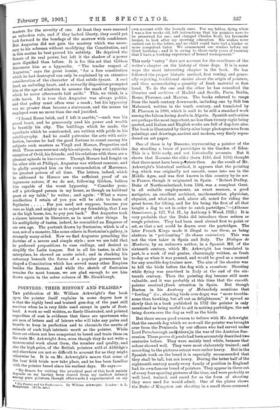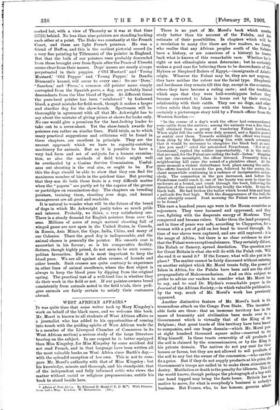POINTERS: THEIR HISTORY AND PRAISES.• Tau publication of Mr. William
Arkwright's fine book upon the pointer itself explains in some degree how it is that the highly bred and trained gun-dog of the past still survives when he is very little used except in parts of Scot- land. A work so well written, so finely illustrated, and printed regardless of cost is evidence that there are sportsmen who are men of letters and of leisure who will take any pains and trouble to keep in perfection and to chronicle the merits of animals of such high intrinsic merit as the pointer. While there are others not less competent to breed and train them on the scale Mr. Arkwright does, even though they do not write a monumental work about them, the number and quality, and also the high price, of the British pointers sold at Aldridge's and elsewhere are not so difficult to account for as they might otherwise be. It is on Mr. Ark wright's moors that some of the best field trials now take place, and he has been familiar with the pointer breed since his earliest days. He says :—
" My fitness for writing the practical part of this book mainly depends on my having been reared from my earliest infancy among pure pointers, though afterwards I experimented on my e The Pointsr and his Predeciss)rs. By William Arkwright. Landon : A. L. Rtuaphreys. 153 Se. net.1
own account with the houndy ones. For my father, dying when I was a few weeks old, left instructions that his pointers were to• be preserved for me ; and charged Charles Scott, his favourite keeper, to look after my sporting education. His wishes were carried out to the letter, and no child could have had a kinder or more competent tutor. We commenced our studies before my third birthday ; and it is owing to those early years of training that I have a working experience of kennel management."
This early " entry " does not account for the excellence of the writer's chapter on the history of these dogs. It is in some
ways the most interesting chapter in the book. He has followed the proper historic method, first testing, and gener- ally rejecting, traditional stories about the origin of pointers, and then accumulating a quantity of fresh material at first hand. To do the one and the other he has consulted the libraries and archives of Madrid and Seville, Paris, Berlin, Rome, Florence, and Mantua. The books referred to range from the tenth century downwards, including one by Sidi ben Mahomed, written in the tenth century, and translated by M. Pharaon in 1880, which is said to be still a standard work among the falcon-loving Arabs in Algeria. Spanish authorities are perhaps the most important, no less than twenty-eight being quoted, and Italian and English works are full of dog-lore also. The book is illustrated by thirty-nine large photogravures from paintings and drawings, ancient and modern, very finely repro- duced on art paper.
One of these is by Bassano, representing a pointer of the day standing a brace of partridges in the Garden of Eden. This is a little early, and not historically accurate. But it shows that Bassano the elder (born 1510, died 1592) thought that there must have been petnters then. As the result of Mr. Arkwright's historical method, it appears that the pointing dog, which was originally not smooth, came into use in the Middle Ages, and was first known in this country by its use in France, though it originated in Spain. "Robert Dudley, Duke of Northumberland, born 1504, was a compleat Gent.
in all suitable employments, an exact seaman, a good navigator, an excellent architect, mathematician, physician, chymist, and what not, and, above all, noted for riding the great horse, for tilting, and for his being the first of all that taught a dog to set in order to catch partridges."—(Athens Or,onienses, p. 127, Vol. II., by Anthony k Wood, 1721.) It is- very probable that the Duke did introduce these setters or rough pointers. They had been used abroad first to point or set, so that a net could be drawn over the partridges. The later French Kings made it illegal to use them, as being abettors in " pot-hunting " (la chasse cuisiniere). This was not the view taker in Spain and Italy. The Dialogos de Monteria, by an unknown author, in a Spanish MS. of the sixteenth century, which Mr. Arkwright has translated in part, is a work of real genius, charmingly written, as fresh to-day as when it was penned, and would be good as a manual for any sensible dog-trainer now. The aim of the shooter was to kill the birds before the dog with a crossbow. Shooting while flying was practised in Italy at the end of the six- teenth century. Then the pointing dog became still more valuable, and it was probably at this time that the smooth pointer received. (fresh attention in Spain. But though Burton in his Anatomy of Melancholy mentions that " fowling" (i.e , shooting birds over dogs) was " more trouble- some than hawking, but all out as delightsome," it spread so slowly that in a book published in 1732 the pointer is only mentioned as being useful to aid in netting partridges, the net being drawn over the dog as well as the birds.
But there seems good reason to believe with Mr. Arkwright that the smooth dog which we now call the pointer was brought over from the Peninsula by our officers who bad served under Lord Peterborough andjothers:in the war of the Austrian Suc- cession. These perros di punta had been accurately described two centuries before. They were mainly bred white, because that colour showed well. They were most elaborately trained ; and according to the pictures extant were rather heavy. But in the Spanish work on the breed it is especially recommended that they shall be tall, but not heavy. During the latter half of the eighteenth century nearly every family of position in England had its own famous breed of pointers. They appear in three out of every four sporting pictures of the time, and were probably as well bred, trained, and cared for as the form of shooting they were used for would admit. One of the plates shows the Duke of Kingston out shooting in a small three-cornered cocked hat, with a view of Thoresby as it was at that time (1725) behind. No less than nine pointets, are standing backing each other at a point. The Duke was constantly at the French Court, and these are light French pointers. He was a friend of Buffon, and this is the earliest pictorial record (in a very fine painting by Tillemans) of the pointer in England. But that the bulk of our pointers were probably descended from those brought over from Spain after the Peace of Utrecht seems clear from their names. Dogs' names are nearly always perpetuated in their puppies. (' Old Mustard' and Young Mustard,' Old Pepper ' and ' Young Pepper,' in Dandle Dinmont's kennel, will occur to every one.) So our Dons,' Sanchos,' and Peros,' a common old pointer name simply • corrupted from the Spanish perro, a dog, are probably lineal descendants from the blue blood of Spain. At different times the pure-bred pointer has been " reinforced " by foxhound blood, a great mistake for field-work, though it makes a larger and sturdier dog for the show-bench: Sportsmen will be thoroughly in agreement with all that Mr. Arkwright has to say about the mistake of giving prizes at shows for looks only. No one would give a premium for the best-looking loader to take out to a cover-shoot. Yet the show-bench awards for pointers run rather on similar lines. Field trials, as to which many practical suggestions and criticisms will be found in these chapters, are excellent in principle. They are the nearest approach which we have to capacity-catching machinery for animals. But as it is possible to have a - very bad form and set of subjects for a human examina- tion, so also the methods of field trials might well be overhauled by a Canine Service Commission. Useful- ness out shooting is the real aim, or ought to be. For this the dogs should be able to show that they can find the maximum number of birds in the quickest time. But proving that they san do both these feats is a very difficult matter when the " papers " are partly set by the caprice of the grouse or partridges on examination-day. The chapters on breeding pointers, training them, shooting over dogs, and kennel management are all good and readable.
It is natural to wonder what will be the future of the breed of dogs in which Mr. Arkwright justly takes so much pride and interest. Probably, we think, a very satisfactory one. There is a steady demand for English pointers from over the seas. Millions of acres of rough natural shooting full of winged game are now open in the United States, in Canada, in Russia, Asia Minor, the Cape, India, China, and many of our Colonies. There the good dog is indispensable, and the animal chosen is generally the pointer. His smooth coat is • somewhat in his favour; so is his comparative docility. Setters, though highly prized, do not seem to be such cosmo- politan favourites. But it is most important to keep the blood pure. We are all against alien crosses, of hounds and other breeds. Such crosses are quite contrary to experience in other lines of animal excellence, where the first object is always to keep the blood pure by dipping from the original spring. The practical test of a well-bred line is whether they do their work in the field or not. If our pointer-owners breed consistently from animals noted in the field trials, their pedi- gree animals are fairly certain to satisfy their customers abroad.











































 Previous page
Previous page